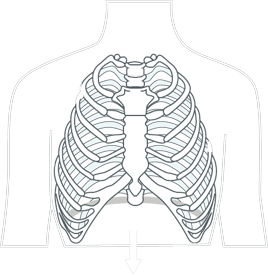HOW TO SING USING YOUR DIAPHRAGM - FREE LESSONS
What is the purpose of your diaphragm? Simply put, your diaphragm is a muscle that helps you to breathe in and out and in effect, allows you to control your breathing. It is virtually a dome shaped/flattened muscle that is vital in this regard. The diaphragm helps pull air into your lungs when you breathe in and once you breathe out, it then helps to push the air out of your lungs.
The diagram on the right displays what happens to your diaphragm when you inhale (breathe in) and exhale (breathe out). It no doubt plays a vital role when singing as you will see further. Singing requires the breathing support from the diaphragm, hence its great importance. It uses the muscle to force air from the lungs and through the voice. Singing involves taking in larger and fuller breaths and so it is important for one to learn how to strengthen this muscle.
The first thing you need to do is to locate your diaphragm. It is not the easiest muscle to find but the best way to do this is to ensure that you are standing up. Once you stand up, place your hands on your stomach, underneath your ribcage and take a deep breath – this will then expand your stomach. As you breathe out slowly, your lungs will then deflate. Ensure that while you do this, your shoulders and chest is still, which will help you to maintain control. A simple exercise can be done to strengthen the core of your diaphragm and will teach you how to breathe correctly.
The objective is to get as much power as you can into your diaphragm. A good trick is to imagine that you are sucking through a straw – hold your shoulders and chest intact and place your hand on your stomach. Ensure that your back is straight and avoid any curved positions while you are doing this exercise. Continuous repetition will train you in using your diaphragm to the best that you can.
It is important incorporate such breathing exercises, along with your diaphragm strengthening because it helps support your voice. Another good way to practice breathing well is to lie on your back on the floor with your hands on your stomach. If you breathe in, your hands will rise and if you breathe out, they will lower. Practicing this technique will help you to train your breathing. When you are singing, you are attempting to control the slow exhaling long breaths. In order for the long notes to be controlled, your diaphragm has to step in. So how do you do it?
Singing from your diaphragm requires you to undergo the following:
1.Ensure you familiarise yourself with natural breathing using the diaphragm.
2.Stand up and erected when you sing, to project and level the circulation of air.
3.Make sure that your back is straight and your posture is correct.
4.Undergo breathing exercises that strengthen your diaphragm.
You must be able to feel the air in your stomach expanding when you practice.
5.Open your mouth when you are singing as this will allow for a good air circulation.
2.Stand up and erected when you sing, to project and level the circulation of air.
3.Make sure that your back is straight and your posture is correct.
4.Undergo breathing exercises that strengthen your diaphragm.
You must be able to feel the air in your stomach expanding when you practice.
5.Open your mouth when you are singing as this will allow for a good air circulation.
Three things to look out for:
1.Your stomach/belly will expand outwardly.
2.Your back will also expand outwardly.
3.Your sides will also expand outwardly.
2.Your back will also expand outwardly.
3.Your sides will also expand outwardly.
Diaphragm Exercises
Place one hand under your ribs to get an idea of where your diaphragm is located. Then place your index finger an inch away from your lips and begin exhaling. When you are breathing out, try and note how your diaphragm moves. When you are singing, do not push too hard to get the air out of your vocal cords.
When you practice your natural breathing, look for the 3 indicators above – this will tell you if you are singing from your diaphragm. Once you have learned and developed your breathing control, you will be able to hold longer notes with your diaphragm.
During Inhalation

Diaphragm contracts and flattens as the lungs fill up with air
During Exhalation

Diaphragm relaxes and moves upward as the air is released
